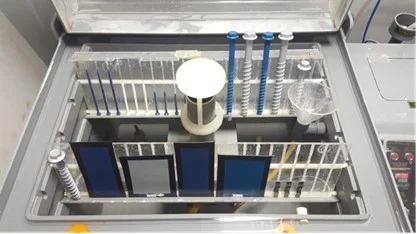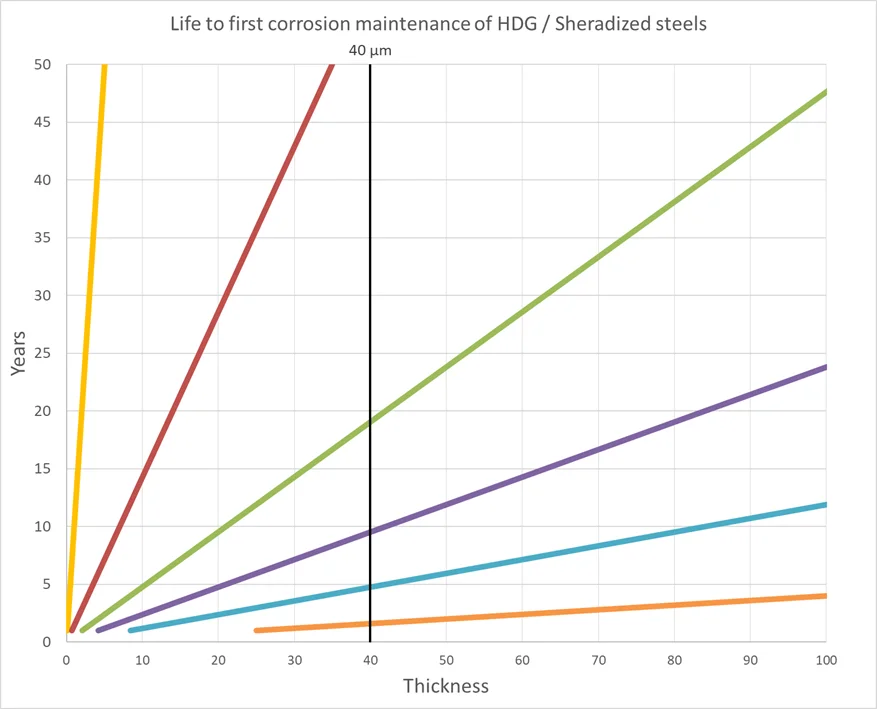The purpose of salt-spray testing steel that has a protective coating is to estimate the service life a particular coating might have in a specific environment. However, salt-spray tests do not always accurately predict how a protective coating may perform in the real world, as is the case with hot-dip galvanized or sherardized steels. It is also used as quality control of the protective coating, to confirm that no defects have occurred during the coating process.
ISO 9227 “Corrosion tests in artificial atmospheres. Salt spray tests” (or the parallel American standard ASTM B-117, “Standard Practice for Operating Salt Spray; fog. Apparatus”), are the most popular standards used to salt-spray test coated steel. This test consists of exposing the coated steel to a 5% sodium chloride fog at a temperature of 35 ºC for a given time. The salt containing mist is sprayed on the coated surface continually without allowing for wet/dry cycling. Coupons are expected to be located in the chamber at 20º from vertical.
The fact the continuous salt-spray fog does not allow for wet/dry cycling is critical to the performance of hot-dip galvanized / sherardized steel, because the zinc patina (zinc carbonate) is not able to form on the galvanized coating. If the zinc patina never forms, an accurate prediction of the real-world performance of hot-dip galvanized / sherardized steel is not possible, since the zinc patina is responsible for the protective properties hot-dip galvanized / sherardize steel is known for.
In other words, the salt-spray test attacks the wrong material (zinc metal instead of the zinc patina), and therefore will give an incorrect prediction of the performance of the hot-dip galvanized / sherardized coating in the real world.

In fact, standards for electroplated coatings as ISO 4042 “Fasteners, Electroplated coating systems” and ISO 10683 “Fasteners. Non-electrolytically applied zinc flake coatings” specify the minimum hours of test resistance to white (coating) or red (base material) corrosion tested according to ISO 9227, whilst standard for hot dip galvanized (ISO 10684 “Fasteners – Hot dip galvanized coatings”) or sherardized (EN 13811 “Sherardize: zinc diffusion coatings on ferrous products. Specification”) do not specify that testing method as applicable for such coatings.
There are other testing methods, where corrosion environment is composed of cycles of one hour in wet salt followed by a second hour in dry conditions. That protocol reflects in a better way the real working conditions of an anchor installed in a construction work. In such conditions the zinc patina can be duly formed on the surface of the hot dip galvanized / sherardized coating, giving a better prediction of its corrosion resistance.
As an alternative, zinc plated coating life, included hot dip galvanized / sherardized, can be predicted using the estimated corrosion rate in different corrosivity categories (C1 to CX) according to ISO 9223 “Corrosion of metal and alloys. Corrosivity atmospheres. Classification”, table 5 together with long term corrosion versus time equation of ISO 9224 section 4 “Corrosion of metals and alloys. Corrosivity atmospheres. Guiding values for the corrosion categories”.. It is summarized in the following graphic, depending on coating thickness and environmental corrosion class.

| Corrosivity category | Corrosivity | Typical environments – Examples from ISO 9223 | |
|---|---|---|---|
| Indoor | Outdoor | ||
| C1 | Very low | Heated spaces with low relative humidity and insignificant pollution, e.g. offices, schools, museums. | Dry or cold zone, atmospheric environment with very low pollution and time of wetness, e.g. certain deserts, Central Arctic/Antarctica. |
| C2 | Low | Unheated spaces with varying temperature and relative humidity. Low frequency of condensation and low pollution, e.g. storage, sport halls. | Temperate zone, atmospheric environment with low pollution (SO2 < 5 μg/m3), e.g. rural areas, small towns. Dry or cold zone, atmospheric environment with short time of wetness, e.g. deserts, subarctic areas. |
| C3 | Medium | Spaces with moderate frequency of condensation and moderate pollution from production process, e.g. food-processing plants, laundries, breweries, dairies. | Temperate zone, atmospheric environment with medium pollution (SO2: 5 μg/m3 to 30 μg/m3) or some effect of chlorides, e.g. urban areas, coastal areas with low deposition of chlorides. Subtropical and tropical zone, atmosphere with low pollution. |
| C4 | High | Spaces with high frequency of condensation and high pollution from production process, e.g. industrial processing plants, swimming pools. | Temperate zone, atmospheric environment with high pollution (SO2: 30 μg/m3 to 90 μg/m3) or substantial effect of chlorides, e.g. polluted urban areas, industrial areas, coastal areas without spray of salt water or, exposure to strong effect of de-icing salts. Subtropical and tropical zone, atmosphere with medium pollution. |
| C5 | Very high | Spaces with very high frequency of condensation and/or with high pollution from production process, e.g. mines, caverns for industrial purposes, unventilated sheds in subtropical and tropical zones. | Temperate and subtropical zone, atmospheric environment with very high pollution (SO2: 90 μg/m3 to 250 μg/m3) and/or significant effect of chlorides, e.g. industrial areas, coastal areas, sheltered positions on coastline. |
| CX | Extreme | Spaces with almost permanent condensation or extensive periods of exposure to extreme humidity effects and/or with high pollution from production process, e.g. unventilated sheds in humid tropical zones with penetration of outdoor pollution including airborne chlorides and corrosion-stimulating particulate matter. | Subtropical and tropical zone (very high time of wetness), atmospheric environment with very high SO2 pollution (higher than 250 μg/m3) including accompanying and production factors and/or strong effect of chlorides, e.g. extreme industrial areas, coastal and offshore areas, occasional contact with salt spray. |
Latest revision: FAQ2 rev0